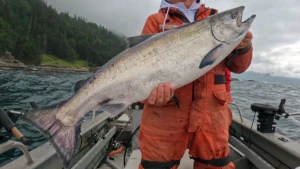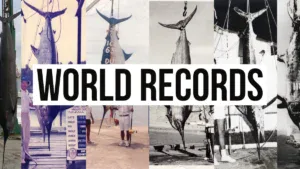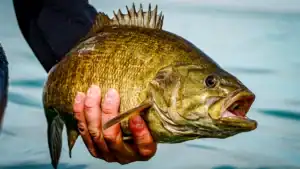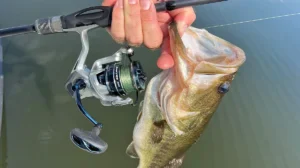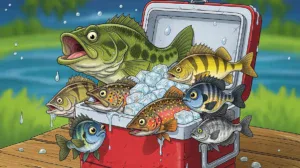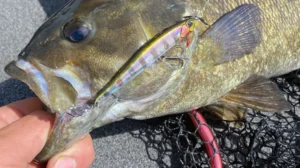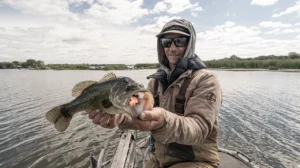What is a buffalo? And what are they doing swimming around our lakes, rivers and creeks?
We’re not talking about the bison that roam the Dakotas and Grand Canyon. In fact, the buffalo I’m talking about are group of fish, with the most common strains: smallmouth, black, and bigmouth. Some anglers know these species as part of the sucker family (Catostomidae). They’d also tell you they grow big, with world records ranging from 63 to 82 pounds, depending on the species.
Recently, Roberta Arostegui was fishing Walter E. Long Reservoir in Texas with guide Austin Anderson when she landed a 54-pound, 7-ounce smallmouth buffalo (Ictiobus bubalus). Arostegui set the 50-pound line-class world record for the species. She fought the fish for 15 minutes, recorded the weight on a certified scale, and safely released it. Roberta has a unique angling history, holding every single women’s line-class record for smallmouth buffalo (8 total).
Channel cats, smallmouth bass, and northern pike don’t grow as large as buffalo. In fact, few freshwater species grow as big, with buffalo rivaling common blue cats and often surpassing muskies. So why don’t more anglers target buffalo? Big fish pull drag no matter the species. And buffalo are accessible in the heartland, available in Lake Erie, Ohio, and Mississippi drainages from Canada to the Gulf. Even states such as Arizona and California.
Buffalo are Suckers

Well, they’re bottom feeders. One look at their face makes it obvious they’re suckers. Buffalo are commonly mistaken for carp, understandably, because of their inferior (subterminal) mouth. That same downward facing mouth can be found on sturgeon, redfish, bonefish and plecos. Buffalo feed mainly on plankton, plants and invertebrates, making them tough targets for hook-and-line, but ideal for bow hunters.
The state of Missouri keeps records of its largest buffalo catches, with different divisions for hook-and-line and bow fishing. In 2024, Ryan Young caught a black buffalo (Ictiobus niger) weighing 55 pounds, 9 ounces from Stockton Lake. “I’m just in shock,” Young said about his record. “It just shows you never know what you’ll catch when you head out.” He was crappie fishing.
Other Missouri records include Allen Schweiss’ 36-pound, 12-ounce smallmouth buffalo from Lake of the Ozarks in 1986. Looking further into the archives, Dr. W. J. Long caught a bigmouth buffalo (Ictiobus cyprinellus) topping 56 pounds from Lake Loch Loma in 1976. The bow hunting records are even heavier, with a nearly 58-pound bigmouth buffalo recorded in 2017.
Is it Worth Fishing for Buffalo?

Bigmouth buffalo are the largest member of the sucker family, but also likely the most wellknown of the buffalo trio. And catching them on hook and line isn’t easy. Smaller, immature fish are more interested in eating your jig or grub lure. You can find buffalo in slow moving or stagnant water with high turbidity and plenty of vegetation. They can be found just about everywhere — lakes, ponds, slow rivers and creeks, eddies and oxbows.
Buffalo will sometimes eat aquatic plants, aquatic invertebrate larvae, small mollusks and fish. The juveniles tend to be benthic feeders, while adults are often plankton filter feeders. Fly fishermen might have an edge here, if you can believe it. Flies to catch carp or even mullet exist that look nothing like a fish, but more like an invertebrate headed for the mud. Mop flies and woolly buggers fit the bill, plus they can be cast directly in front of a buffalo if sight fishing.
For traditional anglers, the best time of year might be April or May during the spawning season. If you can find an aggregation of spawners, they’re surprisingly aggressive. Walleye anglers pitching night crawlers near dams in the spring sometimes catch buffalo. That was my first introduction to buffalo as a kid fishing in Wisconsin. Instead of treating buffalo as an incidental catch, spend a day targeting them. Imagine catching a buffalo on a crappie setup! Tie on a bait that imitates a hellgrammite, maybe one of those popular fuzzy dice plastics, and see if you can hook a giant. This time, the bycatch might even be a smallmouth bass.
Tackle a Buffalo

No one is thinking about creating a Buffalo Pro Tour – they simply aren’t that popular. And with their unwillingness to eat our favorite lure presentations, maybe the allure isn’t there. But Europe has turned the carp into a literal superstar. The bottom feeder has major popularity in countries like France, Hungary, Spain and the Netherlands. They’ve turned a fish that eats corn, boilies and pellets into a science, with an entire fishing industry built on distinct fishing techniques. So maybe there is hope for bigmouths, or or other rough fish species in general.
Personally, sometimes I want to catch something bigger than a walleye, trout or panfish that you can surf across the surface. I truly believe the attraction to catching catfish is hooking into something so large it’s hard to budge. Pure mass at the end of your line. That same mindset applies to buffalo. Who doesn’t crave a fish battle that takes a precise presentation and extended drag pulling?


